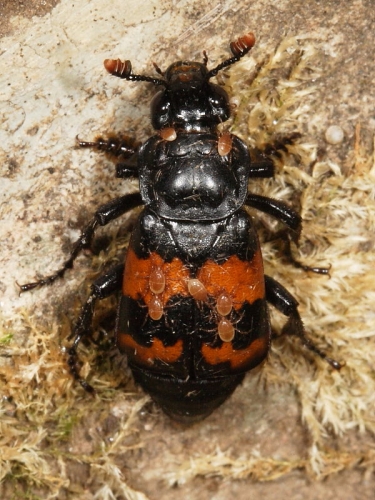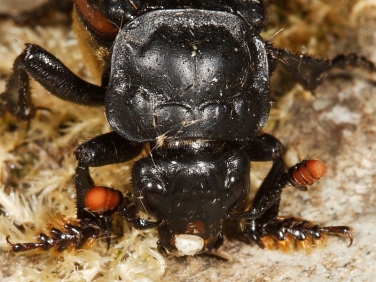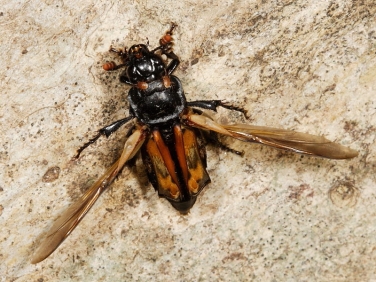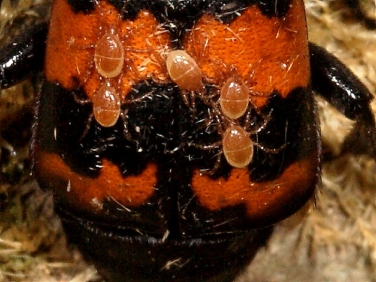This group of beetles are often referred to as burying beetles because they lay their eggs in the soil close to the dead bodies of small mammals and birds which they bury by excavating the soil from around and beneath the corpse so that it slowly sinks into the ground.
The beetle larvae hatch within a few days and feed off the carrion until fully grown and then pupate in the soil from which they emerge the following year as an adult to complete their life-cycle.
The original name for this family or genus is thought to have been Necrophorus from the Greek word ‘necro‘ meaning a dead body but later became mistranslated to ‘nicro‘. Also known as one of the ‘undertakers or gravediggers of the insect world,’ Nicrophorus investigator can be found in a wide range of habitat throughout the UK and is most commonly seen between May and September.
The Sexton beetles locate the decaying food by smell and it seems likely that the bulbous orange-headed tips of the antennae may be particularly sensitive to decaying bodies. When on the ground their wings are folded away beneath a protective casing known as elytra but when revealed extend well beyond the tip of the abdomen. They may fly over a mile to find carrion and a male and female pair will then work together to bury the corpse at the same time as fending off other Sexton Beetles intent also on laying eggs. In common with all burying beetles Nicrophorus investigator will often be seen to have tiny spider like creatures attached to them – see image on the left. These are mites and they attach themselves to parts of the beetle where they cannot be brushed off by a sweeping leg or dislodged in flight.On occasions a beetle can be found that is covered by a writhing mound of these mites but they appear to cause the host no harm other than causing a degree of irritation. The mites are merely hitching a lift to the carrion on which they then lay their eggs.
In fact, it may be that the mite larvae are actually improving the survival chances of the beetle larvae by eating the maggots of flies also feasting on the carrion and so reducing the competition for food. Certainly, where there is insufficient food available to feed the beetle larvae then many will not survive as an alternative food source is unlikely to be within close enough proximity.
The identification of the five orange and black species of British Sexton beetle regularly recorded isn’t always immediately obvious but identification is possible if the following features are looked for:
- Nicrophorus vespilloides is the only one with all black antennae
- Nicrophorus vespillo has yellowish hairs around the front of the thorax and bent hind leg tibia
- Nicrophorus vestigator has yellowish hairs over much of its thorax and a straight hind leg tibia
- Nicrophorus investigator has an almost unbroken orange upper band
- Nicrophorus interruptus has a distinctly broken upper orange band
While another large beetle, Nicrophorus humator, is the only all black Sexton burying beetle species apart from its orange antennae tips.
Related pages: Beetle posts | British beetles gallery



